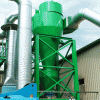 Cyclone separators provide a method of removing particulate matter from gas streams at low cost and low maintenance.
Cyclone separators provide a method of removing particulate matter from gas streams at low cost and low maintenance.In general, a cyclone consists of an upper cylindrical part referred to as the barrel and a lower conical part referred to as the cone. The gas stream enters tangentially at the top of the barrel and travels downward into the cone, forming an outer vortex. The increasing gas velocity in the outer vortex results in a centrifugal force on the particles, separating them from the gas stream. When the gas reaches the bottom of the cone, an inner vortex is created, reversing direction and exiting out the top as clean gas while the particulates fall into the dust collection chamber attached to the bottom of the cyclone.
Pressure drop calculations in gas-solid cyclones are at best empirical due to the fact that effects such as gas compression at the inlet nozzle, wall friction due to tangential flow and exit contraction of the gas leaving the cyclone are difficult to predict in terms of general friction loss equations.
Correlations for the pressure drop using empirical methods are acceptable up to Delta P = 10 in. H20. The pressure drop (Delta P) or the frictional loss is expressed in terms of the velocity head based on the cyclone inlet area. The frictional loss through cyclones is from 1 to 20 inlet velocity heads and depends on the geometric ratios.
Today's blog entry presents an Excel workbook for calculating pressure drop in a gas-solid cyclone using an empirical method. The Excel workbook uses USC units. Reference for the empirical equation used is provided in the excel workbook.
Enjoy downloading the Excel workbook and hoping to have some comments from the members of "Cheresources" on this blog entry.
Download the MS Excel Spreadsheet Here
Regards,
Ankur

 FB
FB





